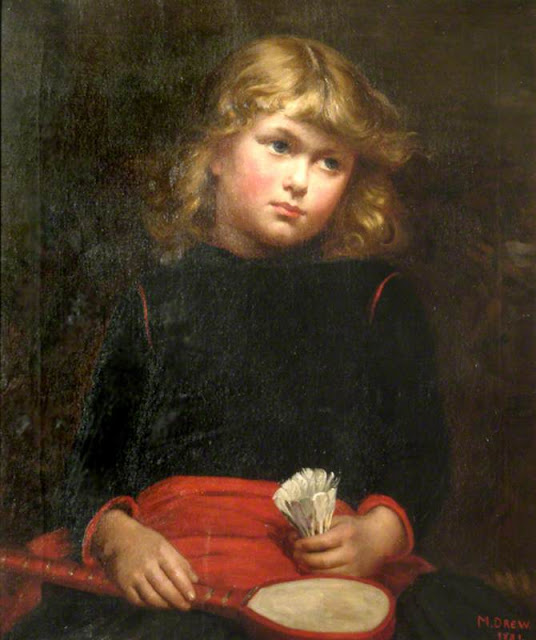Hello again and for my third post of the week I just wanted to give you a bit of an update on my exhibition 'Telling Tales' which is all about Victorian narrative art. It finished its run at the Russell-Cotes in March and has opened in Southampton!
Many thanks to the ever-patient Mr Walker for the photographs of the new venue. For those of you who haven't visited the art gallery in Southampton, it is a very different space to the Russell-Cotes in Bournemouth. As you can see from the image, it is a bright, airy modern gallery which was exciting to hang in.
 |
| I Cannot Play Alone (1881) Mary Drew |
At first glance, this sulky little moppet seems to be pouting because she is unable to entertain herself, however the painting and the artist tell very interesting stories. The title comes from a poem by Felicia Hemans ('The Child's First Grief') and the reason the little girl cannot play is hinted at by her black dress. Yes, she is mourning her brother, her previous playmate and cannot understand why her life continues without him while there are reminders of everything they shared everywhere...
Oh! call my brother back to me!
I cannot play alone;
The summer comes with flower and bee—
Where is my brother gone?
“The butterfly is glancing bright
Across the sunbeam’s track;
I care not now to chase its flight—
Oh! call my brother back!
“The flowers run wild the—flowers we sow’d
Around our garden tree;
Our vine is drooping with its load—
Oh! call him back to me!”
*sob!* Crikey, I think it is especially poignant that the litle girl wants to play badminton, a game you really cannot play on your own, which makes her loss particularly painful.
I was really interested in Mary Drew (1857-1934) who appears to have been a very popular child portraitist in her time but is mostly forgotten now with this painting being the only one on ArtUK, therefore the only oil in public hands. I will delve deeper into her life at some point but in the meantime I have contacted English Heritage as her cottage, called 'Drew Cottage' after her occupation of it, is listed and I added her connection to it the listing.
Another new painting is one with a very local connection...
 |
| The Casualty List (1903) Leonard Skeats |
I was so pleased that I could use this piece in the second leg of the show as it is a marvellous moment of narrative art. The group of women in the cottage are washing clothes but one has paused to read the casualty list from the Boer War. I think we can guess by her expression that it is not good news, or maybe the physical effort of reading through the dead every day to see if your loved one is there has just taken a terrible toll on her? While I had the massive painting of Major Allan Wilson at the Shangani in the Russell-Cotes run of the exhibition, the toll of colonial war on women left at home is rarely shown. I would love to gather together any paintings that explored the experience of these women in Victorian and Edwardian life, before the mass mobilisation of the World Wars. I can only think of Byam Shaw's Last Year Things Were Greener but will seek out more and please comment any you can think of. Leonard Skeats painting is very moving as you see her friends notice the woman's distress and what makes it very special to the Southampton show is that it was painted in Eling, on the west of Southampton. The Art Gallery have a few pieces of his work as he was a local chap and it is all interesting but there is something about the claustrophobic nature of The Casualty List that makes it feel very immediate and real.
You can find more information about the exhibition here and it is running until July. I will be doing some talks and tours, so will set up a tab on the top of the page to add events to so you can come and see me in person!


Congratulations, Kirsty. It is doubtful I'll be able to visit (sadly) but I hope the exhibition is hugely popular!
ReplyDeleteBest wishes
Ellie